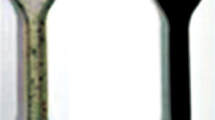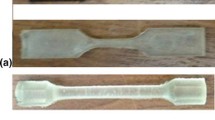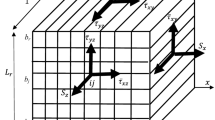Abstract
Because of the natural inconsistency of mechanical and thermal properties of fiber and matrix, residual stresses are introduced during the curing process of fibrous polymer composites. Considering high Young’s modulus and negative coefficient of thermal expansion (CTE) of carbon nanotubes (CNTs), incorporation of CNTs into the matrix makes the matrix properties closer to the fiber ones and reduces residual stresses in laminated polymeric composites. In the present research, through a systematic theoretical study, effects of addition of small amounts of CNTs on micro- and macro-residual stresses in carbon fiber (CF)/epoxy laminates were investigated. First, micro-mechanics equations were employed to investigate CNTs effects on CTE and Young’s modulus of CNT/epoxy and CNT/CF/epoxy composites. Then, the micro- and macro-residual stresses were calculated using the energy method and classical lamination theory (CLT), respectively. The results indicate that addition of low amounts of the CNT causes the matrix CTE to decrease and the matrix Young’s modulus to increase, which in turn leads to a considerable reduction in micro- and macro-thermal residual stresses.









Similar content being viewed by others
References
Al-Saleh MH, Sundararaj U (2011) Review of the mechanical properties of carbon nanofiber/polymer composites. Compos A 42:2126–2142
Badrinarayanan P, Rogalski MK, Kessler MR (2012) Carbon fiber-reinforced cyanate ester/nano-ZrW2O8 composites with tailored thermal expansion. ACS Appl Mater Interfaces 4(2):510–517
Breton Y, D’esarmot G, Saivetat JP (2004) Mechanical properties of multi-walled carbon nanotube/epoxy composite: influence of network morphology. Carbon 42:1027–1030
Chow TS (1978a) Effect of particle shape at finite concentration on thermal expansion of filled polymers. J Polym Sci Polym Phys Edit 16(6):967–970
Chow TS (1978b) Effect of particle shape at finite concentration on the elastic moduli of filled polymers. J Polym Sci Polym Phys Edit 16(6):959–965
Cox HL (1952) The elasticity and strength of paper and other fibrous materials. Br J Appl Phys 3:72–79
Ersoy N, Vardar O (2000) Measurement of residual stresses in layered composites by compliance method. J Compos Mater 34:575–598
Gascoigne HE (1994) Residual surface stresses in laminated cross-ply fiber-epoxy composite materials. Exp Mech 34:27–36
Gay D, Hoa SV, Tsai SW (2002) Composite materials: design and applications, 1st edn. CRC Press, Boca Raton
Godara A, Mezzo L, Luizi F, Warrier A, Lomov SV, van Vuure AW, Gorbatikh L, Moldenaers P, Verpoest I (2009) Influence of carbon nanotube reinforcement on the processing and the mechanical behaviour of carbon fiber/epoxy composites. Carbon 47(12):2914–2923
Gojny FH, Wichmann MHG, Köpke U, Fiedler B, Schulte K (2004) Carbon nanotube-reinforced epoxy-composites: enhanced stiffness and fracture toughness at low nanotube content. Compos Sci Technol 64:2363–2371
Green KJ, Dean DR, Vaidya UK, Nyairo E (2009) Multiscale fiber reinforced composites based on a carbon nanofiber/epoxy nanophased polymer matrix: synthesis, mechanical, and thermomechanical behavior. Compos A Appl Sci Manuf 40(9):1470–1475
Halpin JC, Kardos JL (1976) The Halpin–Tsai equation: a review. Polym Eng Sci 16:344–352
Hodges J, Yates B, Darby MI, Wostenholm GH, Clement JF, Keates TF (1989) Residual stresses and the optimum cure cycle for an epoxy resin. J Mater Sci 24:1984–1990
Hosseini-Toudeshky H, Mohammadi B (2009) Thermal residual stresses effects on fatigue crack growth of repaired panels bounded with various composite materials. Compos Struct 89:216–223
Hsiao KT, Gangireddy S (2008) Investigation on the spring-in phenomenon of carbon nanofiber-glass fiber/polyester composites manufactured with vacuum assisted resin transfer molding. Compos A Appl Sci Manuf 39:834–842
Kim JW, Lee JH, Kim HG, Kim HS, Lee DG (2006) Reduction of residual stresses in thick-walled composite cylinders by smart cure cycle with cooling and reheating. Compos Struct 75:261–266
Kim SS, Murayama H, Kageyama K, Uzawa K, Kanai M (2012a) Study on the curing process for carbon/epoxy composites to reduce thermal residual stress. Compos A Appl Sci Manuf 43(8):1197–1202
Kim HS, Yoo SH, Chang SH (2012b) In situ monitoring of the strain evolution and curing reaction of composite laminates to reduce the thermal residual stress using FBG sensor and dielectrometry. Compos B Eng 44(1):446–452
Lively B, Kumar S, Tian L, Zhong WH (2011) Mechanical, thermal and morphological characterization of polycarbonate/oxidized carbon nanofiber composites produced with a Lean 2-step Manufacturing process. J Nanosci Nanotechnol 11(5):3929–3937
Lubineau G (2008) Estimation of residual stresses in laminated composites using field measurements on a cracked sample. Compos Sci Technol 68:2761–2769
Maple 12, copyright 1981–2008 by Waterloo Maple Inc
MATLAB Release 14 (2004) The MathWorks, Natick, MA
Montazeri A, Javadpour J, Khavandi A, Tcharkhtchi A, Mohajeri A (2010) Mechanical properties of multi-walled carbon nanotube/epoxy composites. Mater Des 31:4202–4208
Nishino T, Kotera M, Sugiura Y (2009) Residual stress of particulate polymer composites with reduced thermal expansion. J Phys Conf Ser 184:120–126
Qian D, Dickey EC, Andrews R, Rantell T (2000) Load transfer and deformation mechanisms in carbon nanotube-polystyrene composites. Appl Phys Lett 76(20):2868–2870
Qiu J, Zhang C, Wang B, Liang R (2007) Carbon nanotube integrated multifunctional multiscale composites. Nanotechnology 18(27), art. no. 275708
Quek MY (2004) Analysis of residual stresses in a single fiber–matrix composite. Int J Adhes Adhes 24:379–388
Ren Y, Li F, Cheng HM, Lio K (2003) Tension fatigue behavior of unidirectional single-walled carbon nanotube reinforced epoxy composite. Carbon 41(11):2177–2179
Shokrieh MM, Safarabadi M (2012) Three-dimensional analysis of micro-residual stresses in fibrous composites based on the energy method: a study including interphase effects. J Compos Mater 46(6):727–735
Tsai SW, Hahn HT (1980) Introduction to composite material. Technomic publishing company, Lancaster, PA
Wang S, Liang Z, Gonnet P, Liao YH, Wang B, Zhang C (2007) Effect of nanotube functionalization on the coefficient of thermal expansion of nanocomposites. Adv Func Mater 17(1):87–92
White SR, Hahn HT (1993) Cure cycle optimization for the reduction of processing-induced residual stresses in composite materials. J Compos Mater 27:1352–1378
Yeh MK, Tai NH, Lin YJ (2008) Mechanical properties of phenolic-based nanocomposites reinforced by multi-walled carbon nanotubes and carbon fibers. Appl Sci Manuf 39(4):677–684
Yokozeki T, Iwahori Y, Ishiwata S (2007) Matrix cracking behaviors in carbon fiber/epoxy laminates filled with cup-stacked carbon nanotubes (CSCNTs). Compos A Appl Sci Manuf 38(3):917–924
Author information
Authors and Affiliations
Corresponding author
Rights and permissions
About this article
Cite this article
Shokrieh, M.M., Daneshvar, A. A Novel Technique to Simulate Reduced Residual Stresses in Laminated Composites Using Nanoparticles. Iran J Sci Technol Trans Mech Eng 43, 17–26 (2019). https://doi.org/10.1007/s40997-017-0114-0
Received:
Accepted:
Published:
Issue Date:
DOI: https://doi.org/10.1007/s40997-017-0114-0




